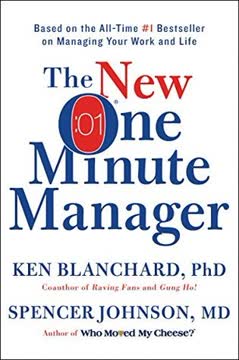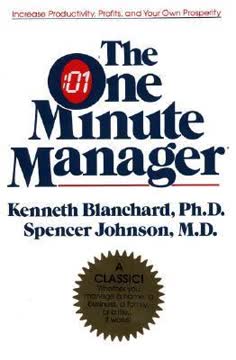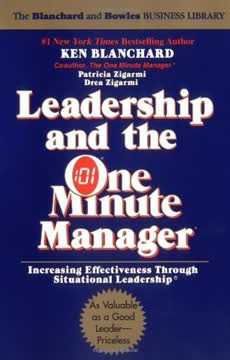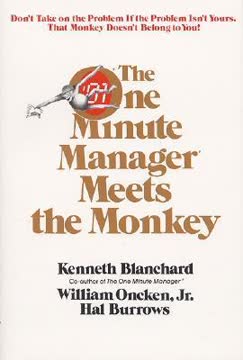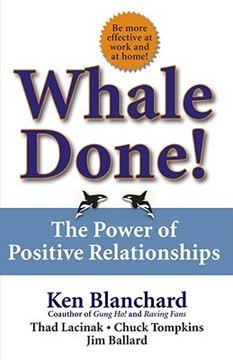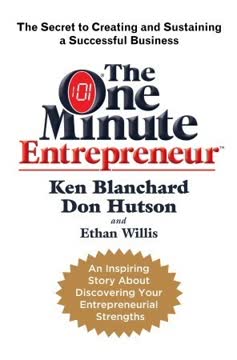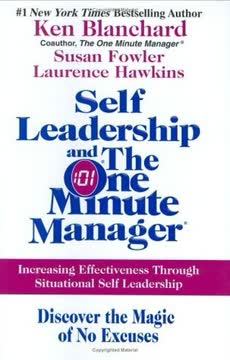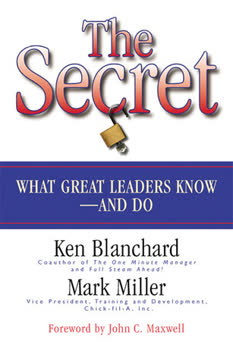Key Takeaways
1. Effective Management: Balancing People and Results
People Who Feel Good About Themselves Produce Good Results
The search for effective management. A bright young man embarked on a global quest to find an effective manager, one who could achieve both organizational success and foster personal growth. He observed two common, yet incomplete, management styles: "tough" managers focused solely on results, often at the expense of their people, and "nice" managers who prioritized people, sometimes neglecting organizational outcomes. He sought a manager who could integrate both, recognizing that true effectiveness lies in a symbiotic relationship between people and productivity.
The One Minute Manager's philosophy. He eventually discovered a unique leader, the "One Minute Manager," who championed the idea that people and results are inextricably linked. This manager understood that when individuals feel good about themselves, they are naturally more motivated and capable of producing high-quality work. This philosophy challenges the traditional dichotomy, asserting that caring for people is not a soft approach but a strategic imperative for achieving superior results.
Quality and quantity. The One Minute Manager emphasized that productivity encompasses both the quantity and quality of work. He illustrated this by pointing to the rise of foreign cars, noting that their success stemmed from delivering the quality the public truly desired, not just producing more vehicles. By focusing on helping people feel good about themselves, the One Minute Manager created an environment where employees were empowered to deliver both high volume and high standards, ensuring long-term organizational success.
2. One Minute Goals: Clear Expectations Drive Performance
The One Minute Manager always makes it clear what our responsibilities are and what we are being held accountable for.
No surprises. The first secret to One Minute Management is One Minute Goal Setting, a system designed to eliminate ambiguity about job responsibilities and performance expectations. Unlike many organizations where employees and their bosses often have differing ideas of what needs to be done, the One Minute Manager ensures crystal-clear understanding from the outset. This proactive approach prevents misunderstandings and ensures everyone is aligned on objectives.
Concise and focused goals. Each goal is meticulously recorded on a single page, limited to no more than 250 words, ensuring it can be read and understood within a minute. The manager applies the 80-20 rule, focusing One Minute Goal Setting on the 20% of goals that will yield 80% of the most important results, typically three to six key areas of responsibility. This brevity encourages frequent review and keeps employees focused on what truly matters.
Defining good performance. Beyond just stating responsibilities, the One Minute Manager ensures employees know what "good performance" looks like. He guides them to define problems in behavioral terms (observable, measurable actions) and to develop their own solutions. This process empowers employees to take ownership and solve problems independently, fostering self-reliance and reducing the need for constant managerial intervention.
3. One Minute Praisings: Catch People Doing Something Right
Help People Reach Their Full Potential Catch Them Doing Something Right
Accentuate the positive. The second secret, One Minute Praisings, is built on the powerful principle of "catching people doing something right." In contrast to most managers who primarily focus on identifying errors, the One Minute Manager actively seeks out and acknowledges positive behaviors. This approach creates a supportive environment where employees feel valued and encouraged, fostering a desire to replicate successful actions.
Immediate and specific feedback. When an employee does something right, the One Minute Manager provides immediate, specific, and sincere praise, often accompanied by a friendly touch like a hand on the shoulder. This prompt feedback ensures the employee clearly understands what they did well and why it was beneficial. The praise is brief, typically under a minute, but its impact is profound, reinforcing desired behaviors much more effectively than delayed annual reviews.
Building self-reinforcement. Initially, the manager closely observes new employees or those starting new tasks to frequently "catch them doing something right." As employees gain experience, they begin to internalize this process, catching themselves doing things right and becoming self-reinforcing. This continuous positive feedback loop, whether external or internal, motivates sustained high performance and helps individuals reach their full potential.
4. One Minute Reprimands: Tough on Behavior, Supportive of the Person
My purpose in a One Minute Reprimand is to eliminate the behavior and keep the person.
Immediate and direct correction. The third secret, One Minute Reprimands, is applied when an experienced employee, who knows how to perform well, makes a significant mistake. The reprimand is delivered immediately after the misbehavior is observed and confirmed, preventing the "gunnysacking" of negative feelings that often characterizes traditional performance reviews. This immediacy ensures the feedback is relevant and impactful, focusing on the specific action rather than accumulated grievances.
Two-part reprimand. The reprimand has two distinct halves. First, the manager looks the employee straight in the eye, clearly states what was done wrong, and expresses their genuine feelings (anger, frustration) about the mistake. This direct, honest feedback, lasting about 30 seconds, is followed by a few seconds of uncomfortable silence, allowing the message to sink in. This "tough" half addresses the behavior unequivocally.
Reaffirming personal worth. The second half of the reprimand shifts to support. The manager reaffirms the employee's value and competence as a person, emphasizing that the anger is directed solely at the behavior, not at them. A handshake or supportive touch concludes the reprimand, making it clear that while the mistake is unacceptable, the person is still highly valued. This "Tough 'n' Nice" approach ensures the behavior is corrected without damaging the individual's self-esteem or their relationship with the manager.
5. Feedback: The Breakfast of Champions
Feedback is the Breakfast of Champions.
The number one motivator. The One Minute Manager firmly believes that the number one motivator of people is clear, consistent feedback on results. Without it, employees are like bowlers trying to hit pins hidden behind a sheet, or golfers playing at night – they lack the essential information to know if they are succeeding. This absence of feedback leads to demotivation and a lack of direction, often resulting in employees simply trying to avoid punishment rather than striving for excellence.
Avoiding "leave alone-zap." Many managers adopt a "leave alone-zap" style, where they leave employees to their own devices, only to "zap" them with criticism when performance falls short. This approach is ineffective and fosters resentment, as employees are punished for not meeting expectations they may not have fully understood. The One Minute Manager's system, in contrast, provides continuous, clear feedback, ensuring employees always know where they stand.
Performance review as an ongoing process. For the One Minute Manager, performance review is not an annual event but an ongoing, daily process. By intervening early and addressing one behavior at a time, feedback is more easily heard and acted upon. This continuous dialogue, whether through goals, praisings, or reprimands, keeps employees engaged, informed, and motivated to improve, transforming feedback into a powerful tool for growth.
6. Invest in People: Your Most Valuable Resource
The Best Minute I Spend Is The One I Invest In People
People are the greatest asset. The One Minute Manager highlights a critical paradox in business: while companies spend 50-70% of their budget on salaries, they often invest less than 1% in training and developing their people. He argues that this is a fundamental misallocation of resources, as people are the engine of productivity. Investing time and effort in employees yields far greater returns than focusing solely on maintaining buildings or equipment.
Three choices for managers. Managers essentially have three choices when it comes to their workforce:
- Hire winners: These individuals are hard to find and costly, but require less direct management.
- Train potential winners: This involves systematically developing individuals with promise into high performers, a core tenet of One Minute Management.
- Pray: This is the default for managers unwilling to invest in the first two, hoping things will work out without active intervention.
The One Minute Manager advocates for the second choice, actively developing talent.
Long-term benefits. By investing in people through clear goals, consistent praise, and fair reprimands, the One Minute Manager cultivates a highly motivated and skilled workforce. This investment leads to significant benefits:
- Reduced personnel turnover
- Less personal illness and absenteeism
- Increased overall organizational effectiveness
This approach not only benefits the employees but also significantly enhances the manager's own career and well-being, freeing up time for strategic thinking and personal health.
7. Separate Behavior from Personal Worth
We Are Not Just Our Behavior We Are The Person Managing Our Behavior
Focus on behavior, not identity. A cornerstone of the One Minute Reprimand's effectiveness is the clear distinction between a person's behavior and their inherent worth. When delivering a reprimand, the manager explicitly targets the specific action that was wrong, never attacking the individual's value or character. This crucial separation prevents defensiveness, allowing the employee to hear and process the feedback about their performance without feeling personally attacked or devalued.
Preserving self-esteem. By reassuring employees of their competence and value in the second half of the reprimand, the One Minute Manager ensures that their self-esteem remains intact. This approach fosters a growth mindset, where mistakes are seen as opportunities for learning and improvement, rather than as reflections of personal inadequacy. Employees are encouraged to manage their own behavior, understanding that their "OK-ness as a person" is never in question.
Caring and respect. This principle underscores the deep caring and respect that underpins One Minute Management. The manager's goal is to eliminate undesirable behavior while retaining and developing the person. This empathetic yet firm approach builds trust and loyalty, making employees more receptive to feedback and more committed to correcting their mistakes. It transforms discipline from a punitive act into a constructive learning experience.
8. Goals Initiate, Consequences Sustain Behavior
Goals Begin Behaviors Consequences Maintain Behaviors
The behavioral cycle. This powerful plaque summarizes the fundamental principles of behavior modification at the heart of One Minute Management. Goals provide the initial direction, clearly outlining what needs to be done and what successful performance looks like. They are the starting gun for action, giving employees a target to aim for and a roadmap to follow.
Reinforcing desired actions. Once behaviors are initiated by clear goals, it is the consequences—specifically One Minute Praisings and One Minute Reprimands—that either reinforce or correct those behaviors. Praisings act as positive reinforcement, making employees feel good about their correct actions and encouraging them to repeat them. Reprimands, when delivered effectively, serve as corrective feedback, discouraging undesirable actions by highlighting their negative impact.
A continuous loop. This creates a continuous loop: clear goals guide behavior, and immediate, specific consequences shape and sustain that behavior over time. Without clear goals, behavior is aimless; without consistent consequences, desired behaviors may not be maintained, and undesirable ones may persist. The One Minute Manager's system ensures this cycle is optimized for maximum productivity and personal growth.
9. The One Minute Manager: A Developer of Talent
After two years with him, they say, ‘Who needs a manager?’ He’s our best trainer of people.
Cultivating independence. The One Minute Manager's effectiveness is strikingly demonstrated by his high "turnover" rate, but not in the traditional negative sense. Instead, his employees, after two years, become so competent and self-sufficient that they are ready to lead their own operations. This unique outcome reveals that the One Minute Manager is not just a boss, but a highly effective trainer and developer of talent, empowering individuals to reach their full leadership potential.
Empowering self-management. By consistently applying One Minute Goals, Praisings, and Reprimands, the manager instills a deep understanding of expectations, fosters self-awareness of performance, and builds confidence in problem-solving. Employees learn to set their own goals, praise their own successes, and even self-correct their mistakes, reducing their reliance on constant supervision. This cultivates a culture of proactive self-management.
A gift of leadership. The manager views his role as giving his people the "gift" of One Minute Management, enabling them to become effective leaders themselves. This approach creates a ripple effect throughout the organization, as these newly empowered managers, in turn, apply the same principles to their own teams. The result is an entire organization populated by capable, confident, and productive individuals, making the One Minute Manager's department a benchmark for success.
10. Honesty and Care: The Foundation of Trust
Manipulation is getting people to do something they are either not aware of or don’t agree to. That is why it is so important to let each person know up front what you are doing and why.
Transparency builds trust. A potential concern with any powerful management system is the risk of manipulation. The One Minute Manager directly addresses this by emphasizing the critical importance of transparency. He ensures that every employee understands "up front" what One Minute Management entails and why these techniques are being used. This open communication prevents feelings of being controlled and fosters a foundation of trust.
Genuine care. The effectiveness of One Minute Management, particularly the reprimands, hinges on the manager's genuine care for the welfare and success of their people. The supportive touch during praisings and the reaffirmation of personal worth during reprimands are only effective if they are perceived as sincere. If employees doubt the manager's motives, these actions can be seen as manipulative, undermining the entire system.
Authenticity and vulnerability. The new One Minute Manager, in his own journey, demonstrated this authenticity by admitting to his staff that he might not always execute the techniques perfectly. This vulnerability further solidified trust, as his team felt he was honestly on their side from the very beginning. This blend of clear expectations, consistent feedback, and genuine human connection makes One Minute Management a powerful, ethical, and highly effective approach to leadership.
Last updated:
Review Summary
The New One Minute Manager receives mostly positive reviews for its concise, practical management advice. Readers appreciate the simple yet effective principles of one-minute goal setting, praising, and redirecting. Many find the book's storytelling approach engaging and easy to understand. Reviewers note its applicability beyond the workplace, including personal relationships. Some criticize the book as overly simplistic, but most agree it offers valuable insights for new and experienced managers alike. The book's brevity and clear takeaways are frequently praised.
Similar Books
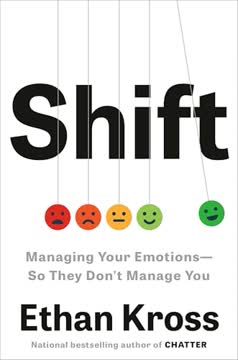

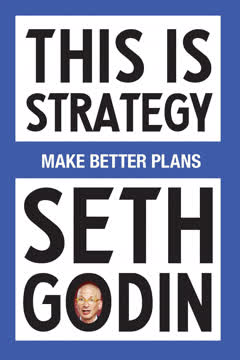

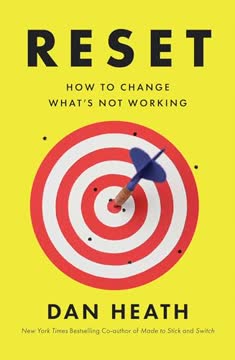



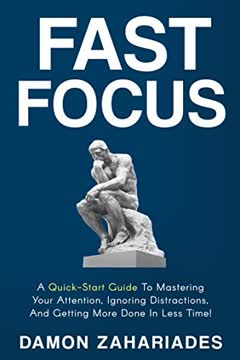
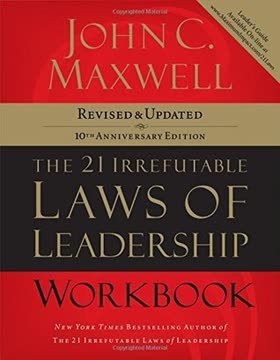
Download PDF
Download EPUB
.epub digital book format is ideal for reading ebooks on phones, tablets, and e-readers.
